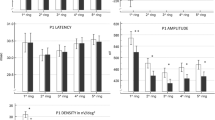Abstract
Purpose
To study whether the ERG and other clinical findings help to distinguish between advanced hydroxychloroquine (HCQ) retinopathy and pericentral or diffuse retinitis pigmentosa (RP) with similar fundus appearance.
Methods
We conducted a retrospective analysis of patients with advanced HCQ retinopathy (n = 11), pericentral RP (n = 8) and diffuse RP (n = 8). Pericentral RP was defined as having limited fundus damage and relatively normal flicker ERG time-to-peak. Diffuse RP had typical loss of the rod ERG and flicker timing delay. All patients showed reduced amplitude of the ISCEV responses in the full-field electroretinogram (ERG). Aspects of history, visual field results, fundus appearance, fundus autofluorescence and ocular coherence tomography were also compared.
Results
Relative to pericentral RP, patients with HCQ toxicity showed delayed flicker ERG time-to-peak and lower ERG amplitudes, particularly combined rod–cone responses. Relative to diffuse RP, most HCQ toxicity patients had some preserved rod ERG response, and there was no obvious predilection for rod over cone damage. In addition, patients with HCQ toxicity usually lacked markers of long-standing degeneration such as bone spicule figures or severe loss of peripheral field. History of familial disease and long-standing night blindness were specific to RP.
Conclusions
While the early signs of HCQ damage are typically regional in the posterior pole, advanced disease is characteristically diffuse (unlike pericentral RP). This is appropriate for a systemic toxin, as is the finding that rods and cones were both affected in the ERG to a similar degree (unlike genetic rod–cone dystrophies). For patients with severe HCQ exposure and some of our discriminatory findings, and no family history or prior night blindness, HCQ toxicity is a sufficient diagnosis without invoking a second rare disease (Occam’s razor).




Similar content being viewed by others
References
Melles RB, Marmor MF (2014) The risk of toxic retinopathy in patients on long-term hydroxychloroquine therapy. JAMA Ophthalmol 132(12):1453–1460
Melles RB, Marmor MF (2015) Pericentral retinopathy and racial differences in hydroxychloroquine toxicity. Ophthalmology 122:110–116
Marmor MF, Kellner U, Lai TYY et al (2016) Recommendations on screening for chloroquine and hydroxychloroquine retinopathy (2016 revision). Ophthalmology 123:1386–1394
Hobbs HE, Sorsby A, Freedman A (1959) Retinopathy following chloroquine therapy. Lancet 2:478–480
Okun E, Gouras P, Bernstein H, Von Sallmann L (1963) Chloroquine retinopathy; a report of eight cases with ERG and dark-adaptation findings. Arch Ophthalmol 69:59–71
Michaelides M, Stover NB, Francis PJ, Weleber RG (2011) Retinal toxicity associated with hydroxychloroquine and chloroquine: risk factors, screening, and progression despite cessation of therapy. Arch Ophthalmol 129:30–39
Marmor MF (2012) Comparison of screening procedures in hydroxychloroquine toxicity. Arch Ophthalmol 130:461
McCulloch DL, Marmor MF, Brigell MG et al (2015) ISCEV standard for full-field clinical electroretinography (2015 update). Doc Ophthalmol Adv Ophthalmol 130:1–12
Sandberg MA, Gaudio AR, Berson EL (2005) Disease course of patients with pericentral retinitis pigmentosa. Am J Ophthalmol 140:100–106
Berson EL, Howard J (1971) Temporal aspects of the electroretinogram in sector retinitis pigmentosa. Arch Ophthalmol 86:653–665
Krill AE, Potts AM, Johanson CE (1971) Chloroquine retinopathy. Investigation of discrepancy between dark adaptation and electroretinographic findings in advanced stages. Am J Ophthalmol 71:530–543
Author information
Authors and Affiliations
Corresponding author
Ethics declarations
Conflict of interest
All authors certify that they have no affiliations with or involvement in any organization or entity with any financial interest (such as honoraria; educational grants; participation in speakers’ bureaus; membership, employment, consultancies, stock ownership or other equity interest; and expert testimony or patent-licensing arrangements) or non-financial interest (such as personal or professional relationships, affiliations, knowledge or beliefs) in the subject matter or materials discussed in this manuscript.
Human and animal rights
All procedures performed in studies involving human participants were in accordance with the ethical standards of the institutional and/or national research committee and with the 1964 Helsinki declaration and its later amendments or comparable ethical standards. The article does not contain any studies with animals performed by any of the authors.
Informed consent
Informed consent was waived by the Institutional Review Board of the Stanford University School of Medicine, as the study is a retrospective chart review.
Rights and permissions
About this article
Cite this article
Nair, A.A., Marmor, M.F. ERG and other discriminators between advanced hydroxychloroquine retinopathy and retinitis pigmentosa. Doc Ophthalmol 134, 175–183 (2017). https://doi.org/10.1007/s10633-017-9588-8
Received:
Accepted:
Published:
Issue Date:
DOI: https://doi.org/10.1007/s10633-017-9588-8




